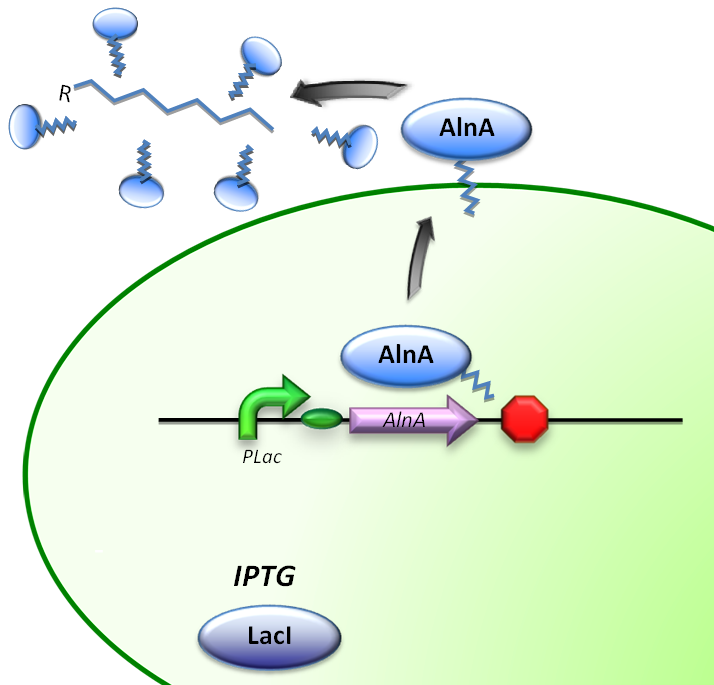Team:TU Delft/Project/solubility/parts
From 2010.igem.org
Hydrocarbon Solubility Parts

Introduction
Before our engineered bugs can start degrading alkanes, they first have to be able to get it in the cell. The problem is that oil hardly dissolves in water. So what we need is just a little drop of soap. But wait a minute, doesn't soap usually kill cells?
Biosurfactant
For this sub-project we made a BioBrick containing a biosurfactant gene. Microorganisms that degrade hydrophobic compounds commonly produce emulsifiers. Acinetobacter radioresistens secretes such a so-called bioemulsan composed of a polysaccharide and three proteins (3). It was shown that AlnA (Accession no. AY033946) constitute most of the emulsifying activity (4-5). Escherichia coli contains an outer membrane protein A (OmpA) that has a high amino acid sequence homology to AlnA. However E. coli OmpA has no emulsifying activity. Comparison of the amino acid sequences of AlnA and E. coli OmpA revealed four hydrophobic regions in AlnA that are absent in E. coli OmpA (2). All these four hydrophobic regions have been shown to be crucial the emulsifying capacity of AlnA (2). Although AlnA is a membrane protein, it has been demonstrated that in several strains of Acinetobacter the protein is secreted (1).
Protein structure
AlnA has an amphipathic structure, which allows it to form micelles that accumulate at the interface between liquids of different polarities such as water and oil. This process is based upon the ability of biosurfactants to reduce surface tension, blocking the formation of hydrogen bridges and certain hydrophilic and hydrophobic interactions. Thus, the emulsifier helps to disperse the oil by solubilization, increasing the surface area and thereby enhancing the growth of microorganisms on hydrocarbons (6-7).
BBa_K398206 - AlnA Emulsifier Protein
The Acinetobacter radioresistens alna gene was synthesized downstream the inducible lacZ promoter (R0011) and medium strong RBS (B0032). The double terminator B0015 was also synthesized at the 5’ of the alna. The synthesized BioBrick was cloned into the pSB1C3 vector and expressed in E. coli K12.
View this part in the parts registry
<partinfo>K398206 SpecifiedComponents</partinfo>
References
- Walzer, G., Rosenberg, E. and Ron, E.Z. (2006) The Acinetobacter outer membrane protein A (OmpA) is a secreted emulsifier. Environmental Microbiology. 8:1026-1032.
- Toren, A., Segal, G., Ron, E.Z. and Rosenberg, E. (2002) Structure--function studies of the recombinant protein bioemulsifier AlnA. Environmental Microbiology. 4:257-261.
- Navon-Venezia, S., et al. (1995) Alasan, a new bioemulsifier from Acinetobacter radioresistens. Applied and Environmental Microbiology. 61:3240-3244.
- Toren, A., Orr, E., Paitan, Y., Ron, E.Z. and Rosenberg, E. (2002) The active component of the bioemulsifier alasan from Acinetobacter radioresistens KA53 is an OmpA-like protein. The Journal of Bacteriology. 184:165-170.
- Toren, A., Navon-Venezia, S., Ron, E.Z. and Rosenberg, E. (2001) Emulsifying activities of purified Alasan proteins from Acinetobacter radioresistens KA53. Applied and Environmental Microbiology. 67:1102-1106.
- Ron, E.Z. and Rosenberg, E. (2002) Biosurfactants and oil bioremediation. Current Opinion in Biotechnology. 13:249-252.
- Suresh Kumar, A., Mody, K. and Jha, B. (2007) Evaluation of biosurfactant/bioemulsifier production by a marine bacterium. Bulletin of Environmental Contamination and Toxicology. 79:617-621.
 "
"


